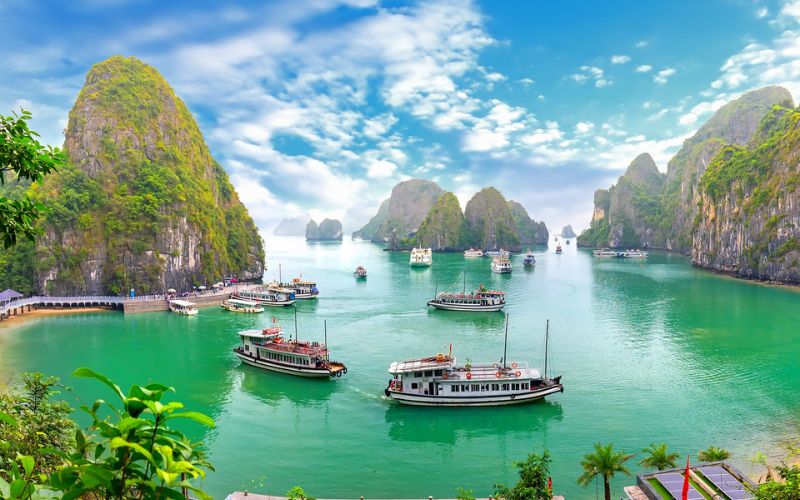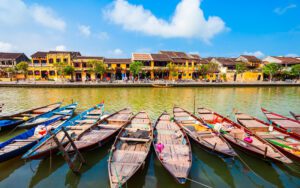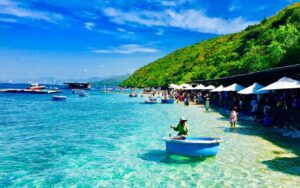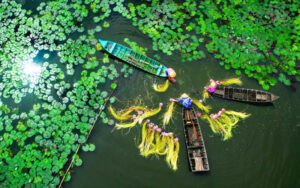1. New Year: 1 day off on the 1 January
2. Traditional New Year or Tết Nguyên Đán: 5 days off, 2 last days and 3 first days of the last and first months on the lunar calendar.
3. HUNG KINGS Festival: 1 day off, 10th day of the third month of the lunar calendar. In 2023, the festival falls on 29 April.
4. Reunification Day: 30 April – 1 day off
5. International Labor Day: 01 May – 1 day off
6. National Day: 02 September – 1 day off
| Date | Weekday | Holiday Name | Holiday Type |
| 1-Jan-2023 | Sunday | New Year’s Day | National holiday |
| 21-Jan-2023 | Saturday | Vietnamese New Year’s Eve | National holiday |
| 22-Jan-2023 | Sunday | Vietnamese New Year, Tết | National holiday |
| 23-Jan-2023 | Monday | Tet holiday | National holiday |
| 24-Jan-2023 | Tuesday | Tet holiday | National holiday |
| 14-Feb-2023 | Tuesday | Valentine’s Day | Observance |
| 10-Mar-2023 | Friday | International Women’s Day | Observance |
| 29-Apr-2023 | Saturday | Hung Kings’ Commemoration Day | National holiday |
| 30-Apr-2023 | Sunday | Liberation Day/Reunification Day | National holiday |
| 1-May-2023 | Monday | International Labor Day | National holiday |
| 28-Jun-2023 | Wednesday | Vietnamese Family Day | Observance |
| 2-Sep-2023 | Saturday | Independence Day | National holiday |
| 20-Oct-2023 | Friday | Vietnamese Women’s Day | Observance |
| 31-Oct-2023 | Tuesday | Halloween | Observance |
| 24-Dec-2023 | Sunday | Christmas Eve | Observance |
| 25-Dec-2023 | Monday | Christmas Day | Observance |
| 31-Dec-2023 | Sunday | International New Year’s Eve | Observance |
Need-to-know Vietnam information for visitors making a Vietnam holiday
Country name: The Socialist Republic of Vietnam – CỘNG HÒA XÃ HỘI CHỦ NGHĨA VIỆT NAM
Capital: Hanoi
Flag: Rectangular in shape with its width equal to two-thirds of its length. In the middle of the fresh red background is a bright five-pointed golden star.
Currency: Vietnam ĐỒNG (VND or đ) is a mix of paper and polymer bills, valued from 10,000 VND to 500,000 VND. No coins are used in Vietnam.
The population as of 2021: 97,47 million
Exchange rate as of March 29th, 2023: 1 US$ ~ 23,485 VND
Time zone: GMT + 7
Vietnam is situated on the eastern coast of the mainland of Southeast Asia, sharing the border with China to the North, Laos to the West, and Cambodia to the Southwest.
Vietnam is located in the sub-tropical area, lying between the Equator and the Tropic of Cancer, with 2 climate sections, The North and The Central + the South.
In Northern Vietnam, the winter/dry season is from November to March, it is cold with the temperature sometimes falling to 5°c or even below zero in mountainous areas. This is the best time to explore Northern Vietnam. The summer/rainy season runs from mid-April to mid-October. At this duration, the average temperature in Hanoi is about 28°c – 34°C with an annual rainfall of 170 cm. In the mountainous area, the annual rainfall may exceed 400mm.
The south is more tropical with the temperatures in the Central (Da Nang) and the South (Ho Chi Minh City) varying from 20 – 35°c throughout the year.
There are 54 groups in Vietnam, and the Viet group (or Kinh) accounts for nearly 90% of the population.
The official language of Vietnam is Vietnamese.
The main means of transportation for Vietnamese people are motorbikes. Cars are becoming more and more popular in recent years.
Vietnam also has a long railways system across the country which was first built in the early 1900s by the French and a total of about 20 airports spreading throughout the country. There are many flights between the North, Central, and South.
Passport/visa (if required), Vaccination, Travel Insurance, Flight tickets, Credit/debit card, some cash, etc.
Your passport must be valid for at least 6 months from the arrival date with at least one blank page.
Vietnam visa exemption: Passport holders from European countries (including Denmark, France, Finland, Germany, Norway, Italy, Sweden, Spain, and the United Kingdom) can visit Vietnam in less than 15 days without a visa.
If you are required a visa to get into Vietnam, please read our directions on Vietnam visa.
Vietnam is an elongated country with an abundance of attractions from North to South. It depends on your time and budget to decide how many days for your trip. If you intend to visit only one destination, less than a week is enough. However, to discover Vietnam from North to South, we recommend you spend at least 8 days on your trip. Traveling for 13 days or more, you will have a chance to visit neighboring countries such as Laos and Cambodia.
For more ideas, you can visit our Vietnam Itineraries.
In Vietnam, only Vietnam Dong (VND) is accepted in any transactions. At some places like hotels, restaurants, shopping centers, etc., travelers can use $USD, $AU, or Euro to pay for goods and services.
Tourists can exchange money at Vietnam banks which are easily found at airports and big cities.
Check the amount of money that one person can bring into Vietnam before starting your trip. You will need to report to the immigration department in Vietnam if you bring more than US $5000 (per person). It is advisable to exchange your money at a bank in Vietnam for a better exchange rate. Check daily exchange rates here.
– In Vietnam, we used 220V, 50Hz and 2 & 3 – pin electricity sockets. Most hotels provide electric outlets with many plug shapes. Universal travel adaptors are needed if you travel with many devices.
– Wifi connection is relatively good in any hotels, coffee shops, and restaurants in Vietnam. However, before traveling to mountainous areas, we recommend you prepare a SIM Card with 3G or 4G service. Check with us if you need a free SIM Card in Vietnam.
With over 3000 kilometers of coastal line and over 4000 years of history, Vietnam is well-known for its rich history, culture, stunning beaches, rivers, well-preserved nature landscapes, Buddhist pagodas as well as bustling cities. These are the top 5 Vietnam travel destinations travelers you should not miss during your trips to Vietnam:

This UNESCO World Heritage Site of Vietnam is famous for its beauty and mysterious allure. Halong Bay attracts travelers and adventurers with thousands of islets and islands raising from calm water. Conveniently located in northern Vietnam, 180 kilometers from Hanoi, 2 or 3 nights on Halong Bay cruises is a must-try experience for any visitors spending a holiday in Vietnam.

The capital of Vietnam, Hanoi is well-known among international tourists as an old and beautiful city. With more than 1000 years of history, Hanoi is famous for its friendly people, amazing street foods, French colonial buildings, Hanoi Old Quarter, many museums, etc. Taking a tour around Hanoi will also give visitors an unforgettable experience.

30 kilometers from Da Nang beach city locates the lovely Hoi An Ancient Town. It is actually a living museum and is recognized as a UNESCO World Heritage Site, attracting a lot of tourists every year.
Visiting Hoi An, you can walk or cycle through unique-architectural structures such as the Japanese Covered Bridge, Ancient Houses, and nearby vegetable or fishing villages.

Located nearly 500 kilometers from Ho Chi Minh City, travelers can get to Nha Trang by daily trains or 1-hour flights from Ho Chi Minh City. There are also 2-hour daily flights from Hanoi to this beach city.
Nha Trang is famous for many long sandy beaches. Travelers can choose a budget hotel in town or a luxury beach resort to enjoy their vacation in Nha Trang. Here, there are many interesting activities to join, such as surfing, snorkeling, bicycle tours, spa treatments, meditation & yoga, etc.

Considered the rice basket of Vietnam, the Mekong delta covers a large agricultural land area in the South of the country with a complex river system. Travelers can visit Mekong Delta in a 1-day trip from Ho Chi Minh City or up to 5 days in the area.
Visit the Mekong Delta, you will see amazing local people’s activities; such as children riding on the back of a water buffalo, girls cycling through country lanes in white ao dai, market vendors grinning behind stacks of fruit, farmers stopping in a sea of emerald; etc.
Vietnam is considered the “kitchen of the world” thanks to its delicious dishes. Joining a cooking class, which is available in many cities, and enjoying your own products would be an unforgettable experience.
Hanoi and Ho Chi Minh City (Saigon) are the realms of exotic life. If you visit these cities at weekend, be sure to visit the night-walking streets to see how bustling they are. This is also a chance for you to enjoy delicious Vietnamese street foods.
If you are going to spend your holidays in Vietnam during late January or early February, do not miss the chance to enjoy the warm atmosphere of the Vietnamese New Year festival with a local family. Tết is the most important time for the Vietnamese people and you will be treated as a very important guest at that time.
Spending your holiday time on sunny beaches is also a smart choice during the Vietnam holidays. This country is home to several world-famous beaches namely Nha Trang, Mui Ne, Phu Quoc, etc. which are fresh and sunny all year round.
With many well-preserved parks, Vietnam is also a wonderful destination for camping trips. Cuc Phuong, Cat Ba National Parks in the North, Tra Su, Nam Cat Tien National Park in the South, or Da Lat city in Central Highland are favorable options.
The summer holiday (school holiday) in Vietnam typically runs from June to early August. During this time, Vietnamese families often opt for beach destinations such as Ha Long, Da Nang, and Nha Trang for their vacations, resulting in higher-than-usual crowds at these locations.
Please note that airfares and train fares are typically more expensive during public holidays. Additionally, it is important to keep in mind that tickets tend to be sold out very quickly, especially one month prior to the 30 April/01 May and Tet holidays. Please contact IDC Travel for assistance in purchasing Vietnam domestic air tickets and train tickets at affordable prices.
During the Vietnam holidays, especially the Tet holiday, many tourist spots, restaurants, shopping centers, etc. are closed (maybe on the third day of Tet or for the whole holiday). However, Vietnam beaches are normally uncrowded and ideal for international tourists to indulge in the pristine clear water and enjoy the tranquil atmosphere. We highly recommend you visit destinations, such as:
On the other hand, avoid famous beach destinations, such as Ha Long, Sam Son, Nha Trang, Da Nang, Phu Quoc, and Vung Tau on other national holidays in Vietnam as they will be crowded with domestic tourists.
If you plan to visit Vietnam during public holidays, especially in the first three days of the Tet holiday, it’s essential to consult a travel agency about destinations, visas, transportation, and accommodations. Additionally, take caution with your belongings when visiting crowded sites and avoid flaunting valuable items like jewelry, cash, or expensive cameras.
Vietnamese people consider Tet to be the most significant holiday in the country. Despite the hectic pace of modern life, everyone makes an effort to prepare for and decorate during this festive season. Typically, families spend time together indoors, and the majority of stores, shopping malls, museums, and restaurants will be closed.
During the Tet holiday, the weather in the North of Vietnam and Hanoi becomes warmer and sunny at times. The average temperature in Hanoi and Halong Bay ranges from 15 to 20°C with low humidity, whereas the highland travel areas of Sapa and Ha Giang remain cool. This season experiences less rainfall, making it one of the best times of the year to visit. However, some parts of Northern Vietnam may still be a bit chilly, so travelers should prepare warm clothing.
On the other hand, the Central and Southern areas of Vietnam, including Hue, Da Nang, Hoi An, Nha Trang, Ho Chi Minh City, and Mekong Delta, are much warmer with an average temperature of around 26-30 °C. It is a great time to visit these places or relax on the beach.
In general, the cost of traveling to Vietnam during the initial three days of the Tet holiday may increase by 20-30% compared to regular days. We suggest you refrain from traveling within the country and instead stay in one location during the first three days of Tet.
Don’t wait until the last minute to apply for a Vietnam visa since immigration offices are very busy before the Tet holiday. Check out the information on the Vietnam visa to know what you need to prepare.
The Tet holiday is not a peak season for domestic travel, so you don’t need to worry about shortages of hotel rooms. Some hotels even organize New Year celebrations for their guests, while others offer significant discounts, so book in advance to join the fun.
The climate in Vietnam is varied from region to region, which means that the best time to travel to the country in terms of the weather will depend on where precisely you go and which activities you join. Broadly speaking, though, Vietnam’s weather patterns can be split into north and south, with two monsoons affecting the climate. The winter monsoon running from October to March typically makes the north of the country cool and damp, while the south is dry and warm. From April/May to October, the summer monsoon generally leads the whole nation to become quite hot and humid, except for the mountains’ surroundings.
Western holidays are not official ones in Vietnam but they are getting more well-known among Vietnamese people. On Christmas and New Year’s Eve, many hotels will decorate their exterior and interior as well as serve holiday buffet dinners to customers. There will be countdown parties and celebrations in major cities such as Hanoi, HCMC, Nha Trang, etc. However, there are only a few hotels decorating for Easter and Thanksgiving and there will not be any holiday dinner served.